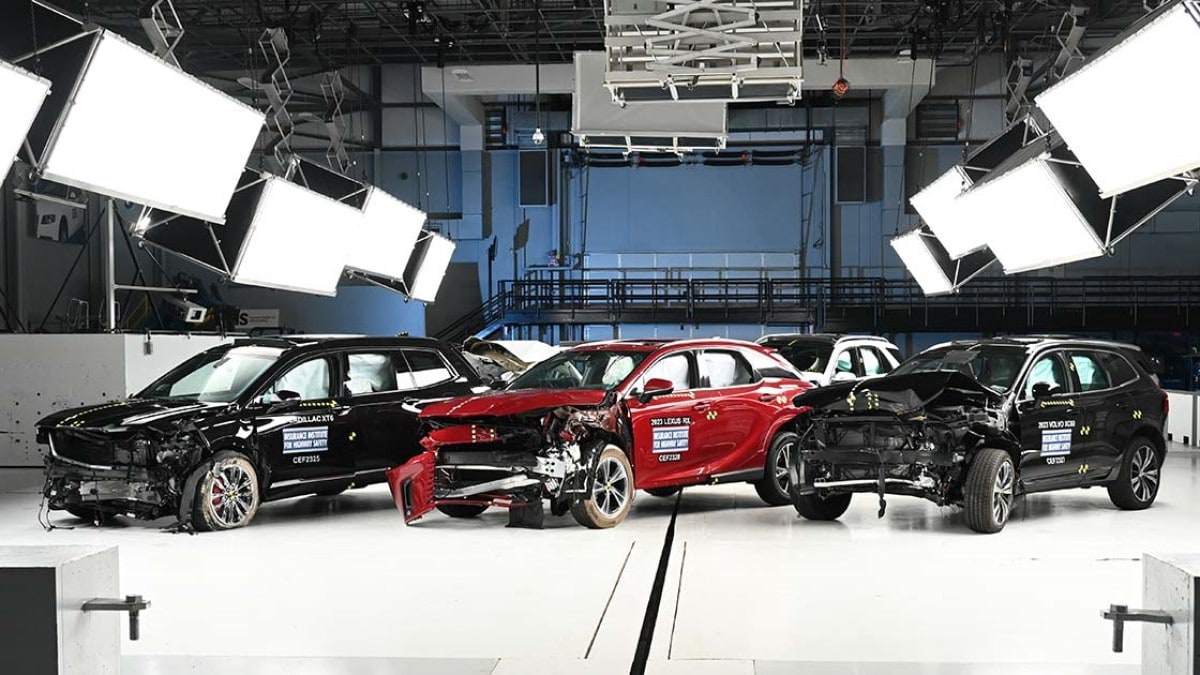The insurance industry is always pushing the auto industry to build safer cars. Throughout 2023, that push has taken the form of a new crash test. And nearly every car has flunked it. But the first round of luxury vehicles has now taken the test. Though most still underperformed, the results were better, with almost half the class earning top marks.
Related: Car Safety Ratings and How They Work
America’s Two Crash-Testing Agencies
America has two organizations that perform crash tests on most new cars.
The federal government’s National Highway Traffic Safety Administration (NHTSA) answers to taxpayers. It played no part in this round of tests.
But there’s a second major safety lab – one that answers to insurance companies. A group of auto insurers fund the Insurance Institute for Highway Safety (IIHS).
The institute has a reputation for tougher tests than the NHTSA. We advise car shoppers to pay attention to both labs’ tests. But keep in mind that the IIHS is the tougher grader.
When NHTSA wants to change its test, it must subject every proposed change to a public comment period and possible congressional scrutiny. Lobbyists try to soften every change.
When IIHS wants to make a test harder, it makes the test harder. Its bosses – your insurance company – want to be as tough as possible.
What’s New? A Child-Size Dummy in the Back
This year, the institute made its frontal offset crash test harder by adding a child-size dummy to the rear seat. The dummy is wired to measure the likelihood of injuries common to rear-seat passengers.
The test sends a vehicle traveling 40 mph into a barrier, offset so that the crash occurs with some overlap — like two cars colliding in an intersection when one is out of its lane.
The IIHS added the second dummy because, it said, “research showed that in newer vehicles the risk of a fatal injury is now higher for belted occupants in the second row than for those in front.” Rear-seat occupants aren’t in more danger than they used to be. Front seats have grown safer.
But many of the safety innovations that protect front-seat passengers haven’t spread to rear seats. By calling attention to that, the institute hopes to push automakers to add more safety features to the second row.
This Hasn’t Gone Well for Most Classes of Cars
Most midsize cars struggled with the new test.
Most midsize SUVs fell short, too.
You’re picking up on a theme, aren’t you? Minivans all underperformed.
Almost every large truck earned the lowest possible score.
Midsize trucks did little better.
But none of those models were built by luxury automakers. Luxury vehicles often carry the latest safety features. More money can buy you more safety.
In the first round of tests involving luxury vehicles, three of eight luxury midsize SUVs earned top marks.
The Results
The IIHS rates vehicles as Good, Acceptable, Marginal, or Poor based on the likelihood of injuries to the driver and, now, second-row passenger.
| Vehicle | Overall Rating | Driver Restraints & Kinematics Score | Rear Passenger Restraints & Kinematics Score |
| 2023-2024 Lincoln Aviator | Good | Good | Acceptable |
| 2024 Mercedes-Benz GLE | Good | Good | Good |
| 2023-2024 Volvo XC60 | Good | Good | Good |
| 2023-2024 Acura MDX | Acceptable | Good | Poor |
| 2023-2024 BMW X3 | Acceptable | Good | Marginal |
| 2023-2024 Audi Q5 | Marginal | Good | Poor |
| 2023-2024 Lexus RX | Marginal | Good | Poor |
| 2023-2024 Cadillac XT6 | Poor | Good | Poor |
Still Room for Improvement
Every SUV tested protected the driver as well as possible.
In protecting the rear-seat dummy, however, some had the same problem as most less-expensive vehicles. The dummy “submarined,” with part of its torso sliding beneath the lap belt. That, the IIHS says, increases the chance of abdominal injuries.
“Though several vehicles in this class performed extremely well, the fact that we saw submarining in half the models we tested shows that many manufacturers still have work to do to improve restraint systems in the second row,” says institute president David Harkey.
The Rear Seat Is Still the Safest Place for Children
Don’t let these results convince you that moving a child up front is safer. The IIHS notes, “ Even with these developments, the back seat remains the safest place for children, who can be injured by an inflating front airbag, and the rating does not apply to children secured properly in child safety seats.”








